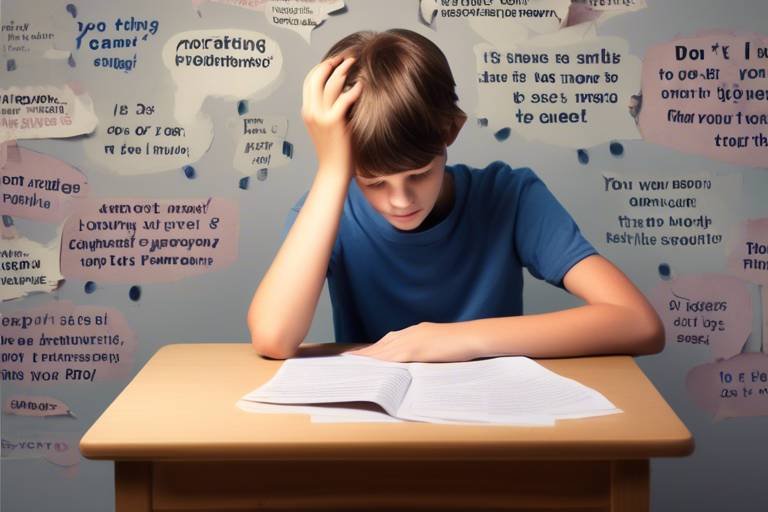Helping Kids Cope with Academic Pressure
In today’s fast-paced world, academic pressure has become a part of the educational landscape. Children are often caught in a whirlwind of expectations, both from parents and peers, which can lead to overwhelming stress. It's essential to recognize that while some pressure can motivate children to excel, too much can be detrimental to their emotional well-being. So, how can we help our kids navigate these turbulent waters? Understanding the roots of academic pressure and implementing effective coping strategies can make a significant difference in their lives.
Academic pressure can stem from various sources, including parental expectations, peer competition, and societal norms. Recognizing these influences is crucial for addressing the stress children face in their educational environments. For instance, parents may unintentionally place high expectations on their children, believing that they are setting them up for success. However, this can lead to feelings of inadequacy if the child struggles to meet those expectations. Similarly, peer competition can create an environment where children feel they must constantly outperform their classmates, adding another layer of stress. By understanding these dynamics, we can better equip our children to cope with the challenges they face.
Identifying the signs of stress in children is essential for timely intervention. Common indicators include changes in behavior, mood swings, and academic performance fluctuations, which can highlight underlying pressure they may be experiencing. For example, if a usually cheerful child suddenly becomes withdrawn or irritable, it may be a sign that they are feeling overwhelmed. Additionally, a drop in grades or a lack of interest in schoolwork can be red flags that should not be ignored. By being vigilant and observant, parents and educators can step in and provide the necessary support before the situation escalates.
Emotional symptoms of stress can manifest as anxiety, irritability, or sadness. Children may find themselves feeling anxious about upcoming tests or assignments, leading to a cycle of worry that affects their overall mood. Understanding these emotional cues helps parents and educators support children effectively during challenging academic periods. For instance, if a child expresses fear about a math test, it’s important for adults to acknowledge those feelings and provide reassurance rather than dismissing them as trivial.
Behavioral changes such as withdrawal from activities or increased aggression can indicate stress. A child who once eagerly participated in sports or hobbies might suddenly lose interest, preferring to isolate themselves. This withdrawal can be a cry for help, signaling that they are struggling to cope with academic demands. Observing these shifts allows caregivers to address the root causes of academic pressure and facilitate open conversations about what the child is experiencing.
Physical symptoms like headaches or stomachaches may arise from stress. Children might complain of feeling unwell, and these complaints can often be linked back to the pressure they feel in school. Recognizing these signs can prompt discussions about the child's emotional state and academic pressures they may be facing. It's crucial for parents to approach these conversations with empathy and understanding, creating a safe space for children to express their feelings.
Implementing effective academic strategies can alleviate pressure. Techniques such as time management, goal setting, and study skills can empower children to navigate their academic responsibilities more effectively. Teaching children how to break down their assignments into manageable tasks can help them feel less overwhelmed. For example, instead of viewing a large project as an insurmountable challenge, they can learn to tackle it step by step, celebrating small victories along the way. This approach not only enhances their academic skills but also builds resilience, preparing them for future challenges.
Parents and educators play a pivotal role in helping children cope with academic pressure. Their support, understanding, and guidance can significantly impact a child's ability to manage stress and succeed academically. By fostering a collaborative relationship, parents and teachers can create a united front that encourages children to express their concerns and seek help when needed.
Open communication between parents, educators, and children fosters a supportive environment. Encouraging discussions about academic challenges can help children feel understood and less isolated in their struggles. Simple questions like, “How was your day at school?” or “What’s been on your mind lately?” can open the door to deeper conversations about stressors they may be facing. The key is to listen actively and validate their feelings, reinforcing that it’s okay to feel overwhelmed at times.
A supportive environment at home and school can significantly reduce academic pressure. Strategies include providing resources, emotional support, and encouraging a balanced approach to education and extracurricular activities. It’s important for children to have time to unwind and engage in activities they enjoy, as this can serve as a buffer against stress. By creating a nurturing atmosphere, we can help children develop the skills they need to thrive academically while maintaining their emotional health.
- What are some signs my child may be experiencing academic pressure?
Look for changes in behavior, mood swings, physical complaints like headaches, or a sudden drop in academic performance. - How can I help my child manage stress?
Encourage open communication, teach time management skills, and ensure they have a balanced schedule that includes downtime. - When should I seek professional help for my child?
If stress is impacting their daily life, relationships, or overall well-being, it may be time to consult a mental health professional.

Understanding Academic Pressure
This article explores effective strategies and insights to help children manage the stress of academic challenges, fostering resilience and emotional well-being in their educational journey.
Academic pressure can be an overwhelming force in a child's life, often stemming from multiple sources. From the moment children step into school, they are bombarded with expectations that can sometimes feel like a heavy backpack they can’t take off. Parental expectations often lead the charge; parents may hope for high grades, college scholarships, or even specific career paths for their children. This pressure can create a sense of urgency that weighs heavily on young minds.
Moreover, peer competition adds another layer to this pressure. Kids often compare themselves to their classmates, leading to a race for the top that can feel relentless. When everyone else seems to be excelling, a child may feel inadequate or anxious about their own performance. It’s like running a marathon where everyone else is sprinting, leaving them gasping for breath.
Lastly, societal norms play a significant role in shaping the academic landscape. The narrative that success is measured by grades and accolades can be pervasive, creating an environment where children feel they must constantly prove themselves. This societal pressure can turn learning into a chore rather than a joy, leading to a cycle of stress that is hard to break.
Recognizing these influences is crucial for addressing the stress children face in their educational environments. By understanding the root causes, parents and educators can better support children in navigating the tumultuous waters of academic life. It’s essential to create a dialogue around these pressures, fostering an atmosphere where children feel safe to express their fears and challenges without judgment.
| Source of Pressure | Description |
|---|---|
| Parental Expectations | Hopes for high grades and future success that can overwhelm children. |
| Peer Competition | Comparisons with classmates that create feelings of inadequacy. |
| Societal Norms | Pressure to achieve high grades and accolades as a measure of worth. |
In conclusion, understanding academic pressure is the first step toward helping children cope with it. By acknowledging the various sources of stress, we can create a supportive environment that prioritizes emotional well-being alongside academic achievement. After all, education should be a journey of discovery rather than a race to the finish line.
- What are the signs of academic pressure in children? Look for changes in behavior, mood swings, and fluctuations in academic performance.
- How can parents help their children cope with academic pressure? Open communication and a supportive environment are key. Encourage discussions about challenges and provide emotional support.
- What role do educators play in alleviating academic pressure? Educators can create a balanced curriculum that emphasizes learning over competition and fosters a supportive classroom environment.

Signs of Stress in Children
Identifying the signs of stress in children is essential for timely intervention. Stress can manifest in various ways, and being aware of these signs can help parents and educators provide the necessary support. Children might not always articulate their feelings, so it's crucial to pay attention to subtle changes in their behavior and mood. Common indicators of stress include changes in behavior, mood swings, and fluctuations in academic performance. These signs can serve as red flags that something deeper is affecting their emotional well-being.
One of the most significant aspects of recognizing stress in children is understanding the emotional symptoms they may exhibit. For instance, a child who was once lively and enthusiastic about school might suddenly become anxious or irritable. This shift can leave parents puzzled, wondering what has caused their child's change in demeanor. Emotional cues like these are vital for parents and educators to notice, as they can indicate that the child is struggling with academic pressures that may not be immediately visible.
Emotional symptoms of stress can manifest in various ways, including:
- Anxiety: Children may express worry about tests, grades, or even the expectations of their teachers and parents.
- Irritability: Increased frustration or anger over minor issues can be a sign that a child is feeling overwhelmed.
- Sadness: A noticeable decline in enthusiasm or joy can suggest that a child is grappling with emotional burdens due to academic stress.
Behavioral changes are another critical indicator of stress. For example, a child who used to participate actively in sports or hobbies might begin to withdraw from these activities. This withdrawal can be a sign that they are feeling overwhelmed by their academic responsibilities. Increased aggression or conflict with peers can also be a manifestation of stress, as children may struggle to manage their emotions effectively. Observing these shifts allows caregivers to address the root causes of academic pressure and offer appropriate support.
Physical symptoms can also arise from stress, often manifesting as headaches, stomachaches, or other unexplained ailments. These symptoms can be particularly concerning, as they may lead to frequent absences from school or reluctance to engage in daily activities. Recognizing these physical signs is crucial, as they can prompt important discussions about the child's emotional state and the academic pressures they may be facing. Parents and educators should take these complaints seriously and explore whether they are linked to stress rather than dismissing them as mere childhood ailments.
In conclusion, recognizing the signs of stress in children is a vital step in helping them cope with academic pressures. By being vigilant and attentive to emotional, behavioral, and physical symptoms, parents and educators can create a supportive environment that fosters resilience and emotional well-being. Early intervention and open communication can make a world of difference in a child's educational journey.
Q: What are the most common signs of stress in children?
A: Common signs include changes in behavior, mood swings, anxiety, irritability, and physical symptoms like headaches or stomachaches.
Q: How can I help my child cope with academic pressure?
A: Providing emotional support, encouraging open communication, and implementing effective academic strategies can help your child manage stress.
Q: When should I seek professional help for my child?
A: If your child's stress signs persist or worsen, or if they begin to affect their daily life significantly, it may be time to consult a mental health professional.

Emotional Symptoms
When it comes to children facing academic pressure, the emotional symptoms they experience can often be the most telling. Imagine a balloon being filled with air; at some point, if too much air is added, it’s bound to pop. Similarly, children who are overwhelmed by academic demands may show signs of emotional distress that indicate they are struggling to cope. Anxiety, for instance, might manifest as a constant feeling of dread or worry about upcoming tests, homework, or even the expectations set by parents and teachers. This feeling can be debilitating, making it hard for them to focus on their studies.
Moreover, irritability can become a frequent visitor in their emotional landscape. A child who once enjoyed playing with friends may suddenly snap at them over trivial matters, or they may become easily frustrated with their schoolwork. This irritability often stems from feeling overwhelmed and can create a vicious cycle, where the child feels more isolated and pressured.
Another emotional symptom to keep an eye out for is sadness. It can be heartbreaking to see a child who used to radiate joy suddenly withdraw into themselves. This can lead to a lack of motivation and interest in activities they once loved, which can further exacerbate their academic struggles. Recognizing these emotional cues is crucial for parents and educators alike, as they offer a window into the child's internal world.
In addition to these symptoms, it’s important to note that children may also experience a mix of emotions, leading to mood swings that can leave them and those around them feeling confused. These emotional fluctuations can be likened to a rollercoaster ride, where one moment they are up, and the next, they are down. Understanding this complexity can help caregivers approach the situation with empathy and support.
By fostering an environment where children feel safe to express their emotions, parents and educators can help them navigate these turbulent feelings. Open discussions about what they are experiencing emotionally can alleviate some of the burdens they carry. So, how can we encourage this kind of communication? Here are a few strategies:
- Encourage children to share their feelings regularly, creating a safe space for them to express themselves.
- Validate their emotions, letting them know that it’s okay to feel anxious or sad.
- Teach them coping mechanisms, such as deep breathing or journaling, to manage their emotions effectively.
Ultimately, recognizing and addressing these emotional symptoms is a vital step in helping children cope with academic pressure. By being attentive to their emotional needs, we can guide them through their challenges and help them develop resilience for the future.
Q1: How can I tell if my child is experiencing academic pressure?
A: Look for signs such as changes in behavior, mood swings, and declining academic performance. Emotional symptoms like anxiety, irritability, and sadness are also significant indicators.
Q2: What can I do to support my child emotionally during stressful academic times?
A: Open communication is key. Encourage your child to express their feelings, validate their emotions, and provide coping strategies to help them manage stress.
Q3: Are there specific strategies to help children manage their academic responsibilities?
A: Yes! Techniques like time management, goal setting, and effective study skills can empower your child to handle academic tasks more efficiently.

Behavioral Changes
When children experience academic pressure, it often manifests through noticeable . As parents and educators, it’s crucial to be vigilant and observant. You might notice your child withdrawing from activities they once enjoyed, like sports or art, which can be a red flag. This withdrawal can feel like a slow fade, almost like watching a vibrant painting lose its colors. Instead of the enthusiastic kid who loved to play soccer, you might find them opting to stay indoors, glued to a screen, avoiding interactions with friends and family.
In addition to withdrawal, increased aggression can also signal that a child is struggling with stress. You might find your little one reacting more explosively to minor frustrations—like a small volcano ready to erupt at any moment. This change in demeanor can be alarming and may leave parents feeling helpless. Understanding that these behavioral shifts are often a cry for help can empower you to take action.
It’s not just about withdrawal or aggression, though. Sometimes, children may exhibit restlessness or an inability to concentrate. Imagine trying to read a book while someone is constantly tapping their foot beside you; it’s distracting and can be frustrating. Children under academic stress may exhibit similar behaviors, making it difficult for them to focus on their studies. Recognizing these signs early can be the key to addressing the underlying issues, allowing for timely intervention.
To better understand these behavioral changes, here’s a quick overview of some common signs:
| Behavioral Change | Possible Interpretation |
|---|---|
| Withdrawal from activities | Feeling overwhelmed or disinterested |
| Increased aggression | Frustration and inability to cope with stress |
| Restlessness | Difficulty concentrating or feeling anxious |
| Changes in sleep patterns | Stress affecting overall well-being |
Recognizing these changes is the first step towards helping children cope with their academic pressures. By fostering an environment that encourages open dialogue about their feelings and experiences, you can help them navigate these turbulent waters. Remember, the goal is not just to alleviate stress but to build resilience, helping your child emerge stronger and more equipped to handle future challenges.
- What are some signs that my child is experiencing academic pressure?
Common signs include withdrawal from activities, mood swings, irritability, and changes in sleep patterns. - How can I support my child who is feeling overwhelmed?
Encourage open communication, help them set realistic goals, and ensure they have a balanced schedule that includes downtime. - Are there specific strategies to help children manage stress?
Yes! Techniques like time management, mindfulness practices, and regular physical activity can be very effective.

Physical Symptoms
This article explores effective strategies and insights to help children manage the stress of academic challenges, fostering resilience and emotional well-being in their educational journey.
Academic pressure can stem from various sources, including parental expectations, peer competition, and societal norms. Recognizing these influences is crucial for addressing the stress children face in their educational environments.
Identifying the signs of stress in children is essential for timely intervention. Common indicators include changes in behavior, mood swings, and academic performance fluctuations, which can highlight underlying pressure they may be experiencing.
Emotional symptoms of stress can manifest as anxiety, irritability, or sadness. Understanding these emotional cues helps parents and educators support children effectively during challenging academic periods.
Behavioral changes such as withdrawal from activities or increased aggression can indicate stress. Observing these shifts allows caregivers to address the root causes of academic pressure.
Physical symptoms like headaches or stomachaches may arise from stress. These manifestations can often be the body's way of signaling that something is amiss emotionally or mentally. Children may not always articulate their feelings, but the physical signs can be a telling indicator of their internal struggles. For instance, a child who suddenly complains of frequent stomachaches might be experiencing anxiety related to upcoming tests or performance expectations. It's essential to recognize these symptoms as more than just trivial complaints; they can be a cry for help.
Here are some common physical symptoms that may indicate academic stress:
- Headaches: Frequent headaches can be a sign of tension or anxiety, often exacerbated by the pressures of schoolwork.
- Stomachaches: Stress can lead to gastrointestinal issues, causing discomfort that may interfere with a child's ability to focus on studies.
- Fatigue: Constant tiredness can result from the mental strain of academic demands, affecting both physical and emotional well-being.
- Changes in Appetite: Some children may eat less due to stress, while others might seek comfort in food, leading to significant fluctuations in their eating habits.
Recognizing these signs can prompt discussions about the child's emotional state and academic pressures they may be facing. Parents and educators should approach these conversations with empathy and openness, creating a safe space for children to express their feelings. Addressing the physical symptoms of stress is just as important as tackling the emotional aspects, as both are interconnected in the journey toward managing academic pressure.
Implementing effective academic strategies can alleviate pressure. Techniques such as time management, goal setting, and study skills can empower children to navigate their academic responsibilities more effectively.
Parents and educators play a pivotal role in helping children cope with academic pressure. Their support, understanding, and guidance can significantly impact a child's ability to manage stress and succeed academically.
Open communication between parents, educators, and children fosters a supportive environment. Encouraging discussions about academic challenges can help children feel understood and less isolated in their struggles.
A supportive environment at home and school can significantly reduce academic pressure. Strategies include providing resources, emotional support, and encouraging a balanced approach to education and extracurricular activities.
- What are the most common signs of academic stress in children?
Common signs include changes in behavior, emotional symptoms like anxiety or irritability, and physical symptoms such as headaches or stomachaches.
- How can parents help reduce academic pressure on their children?
Parents can help by fostering open communication, setting realistic expectations, and encouraging a balanced lifestyle that includes relaxation and play.
- What role do educators play in managing students' academic stress?
Educators can create supportive classroom environments, recognize signs of stress, and provide resources to help students manage their academic responsibilities.

Academic Strategies for Success
When it comes to navigating the rocky terrain of academic life, having a solid set of strategies can feel like holding a compass in a dense fog. **Effective academic strategies** not only help children manage their workload but also build their confidence and resilience. One of the first steps is **time management**. Teaching kids to prioritize tasks can ease the feeling of being overwhelmed. For instance, using a simple planner or digital calendar can help them visualize their deadlines and allocate their study time wisely. Imagine trying to bake a cake without measuring the ingredients—that's what studying without a plan can feel like!
Another crucial strategy is **goal setting**. Children should learn to set realistic, achievable goals, both short-term and long-term. This could mean breaking down a larger project into smaller tasks. For example, if they have a research paper due in a month, they might set weekly goals like completing the outline, gathering sources, and writing the first draft. This approach not only makes the task less daunting but also provides a sense of accomplishment at each milestone. It's like climbing a mountain; each step brings you closer to the summit!
In addition to these strategies, developing **effective study skills** is vital. Children should be encouraged to explore different study techniques to find what works best for them. Some might thrive in a quiet space with flashcards, while others may benefit from group study sessions where they can bounce ideas off their peers. It's essential to remind them that everyone learns differently, and finding their unique style can make studying much more enjoyable. To aid this process, parents and educators can introduce various methods, such as:
- Active Recall: Testing themselves on the material instead of just reading it.
- Spaced Repetition: Reviewing information at increasing intervals to enhance retention.
- Mind Mapping: Creating visual diagrams to organize thoughts and concepts.
Moreover, fostering a **growth mindset** can significantly impact how children perceive challenges. By encouraging them to view setbacks as opportunities for growth rather than failures, they become more resilient. This mindset shift can be as simple as changing the language we use around mistakes. Instead of saying, “You failed,” we can say, “What did you learn from this experience?” This subtle change can empower children to take risks and embrace learning as a lifelong journey.
Finally, it's essential to create a **balance between academics and personal interests**. Encourage children to engage in extracurricular activities that excite them, whether it's sports, music, or art. These activities provide a necessary outlet for stress and can enhance their overall well-being. Just like a well-rounded meal, a balanced approach to life can nourish their minds and spirits, making them better equipped to handle academic pressures.
Q: How can I help my child manage their time effectively?
A: Start by sitting down with them to create a daily or weekly schedule. Include time for homework, breaks, and leisure activities. Encourage them to stick to their schedule as much as possible.
Q: What should I do if my child is struggling with a particular subject?
A: Consider hiring a tutor or seeking additional resources. Sometimes, a different perspective can make all the difference. Also, encourage them to communicate with their teachers for extra help.
Q: How can I encourage a growth mindset in my child?
A: Praise their efforts rather than their intelligence. Emphasize the importance of perseverance and learning from mistakes. Share stories of successful people who faced challenges and overcame them.
Q: What role do extracurricular activities play in managing academic pressure?
A: Extracurricular activities provide a break from academic stress, allowing children to explore their passions and develop new skills. They also promote social connections, which can be a great support system during tough times.

The Role of Parents and Educators
When it comes to helping children navigate the tumultuous waters of academic pressure, the roles of parents and educators are absolutely crucial. Think of them as the captains of a ship, steering their young crew through stormy seas. Their support and guidance can make all the difference in how children cope with stress and succeed in their academic endeavors. So, how can parents and educators work together to create a nurturing environment that fosters resilience?
First and foremost, open communication is key. Parents should feel comfortable talking to their children about school, while educators should encourage students to express their feelings about academic challenges. This two-way street of communication not only helps children feel understood but also allows them to voice their concerns and fears. It’s like having a safety net; when kids know they can talk about their struggles, they’re less likely to feel isolated.
Additionally, creating a supportive environment is vital. This can be achieved by ensuring that children have access to the necessary resources, whether it’s tutoring, study materials, or simply a quiet space to focus on their homework. At home, parents can set up a designated study area that is free from distractions, while educators can provide accommodations for students who may need extra help in the classroom. By fostering a conducive atmosphere for learning, both parents and educators can help alleviate some of the pressures that come with academic responsibilities.
Moreover, it’s important for parents and educators to work together as a team. Regular meetings or check-ins can provide a platform for discussing a child’s progress and any challenges they may be facing. In these discussions, they can share insights and strategies that may help the child cope better with academic pressure. For example, if a child is struggling with time management, parents can reinforce the same study skills that educators are teaching in the classroom. This consistency helps children feel more secure and supported.
In addition, parents can encourage a balanced approach to education. It’s essential for children to understand that while academics are important, so are hobbies, sports, and social interactions. By promoting a well-rounded lifestyle, parents can help mitigate the overwhelming feeling of needing to excel in every single area. After all, children are not just students; they are individuals with diverse interests and talents.
Finally, parents and educators should model healthy coping mechanisms. Children often learn by example, so when they see their parents and teachers managing stress in healthy ways—like exercising, meditating, or simply taking breaks—they are more likely to adopt those strategies themselves. This modeling can be incredibly effective in teaching children how to handle academic pressure without succumbing to it.
- What can I do if my child is overwhelmed by schoolwork?
Encourage open discussions about their feelings, help them prioritize tasks, and consider seeking additional resources like tutoring if necessary.
- How can I recognize if my child is stressed about academics?
Look for signs such as changes in behavior, mood swings, or physical symptoms like headaches. Open communication can help you understand their feelings better.
- What role do extracurricular activities play in managing academic pressure?
Extracurricular activities provide a necessary balance, helping children develop skills outside of academics and allowing them to unwind and socialize.

Communication Techniques
This article explores effective strategies and insights to help children manage the stress of academic challenges, fostering resilience and emotional well-being in their educational journey.
Academic pressure can stem from various sources, including parental expectations, peer competition, and societal norms. Recognizing these influences is crucial for addressing the stress children face in their educational environments.
Identifying the signs of stress in children is essential for timely intervention. Common indicators include changes in behavior, mood swings, and academic performance fluctuations, which can highlight underlying pressure they may be experiencing.
Emotional symptoms of stress can manifest as anxiety, irritability, or sadness. Understanding these emotional cues helps parents and educators support children effectively during challenging academic periods.
Behavioral changes such as withdrawal from activities or increased aggression can indicate stress. Observing these shifts allows caregivers to address the root causes of academic pressure.
Physical symptoms like headaches or stomachaches may arise from stress. Recognizing these signs can prompt discussions about the child's emotional state and academic pressures they may be facing.
Implementing effective academic strategies can alleviate pressure. Techniques such as time management, goal setting, and study skills can empower children to navigate their academic responsibilities more effectively.
Parents and educators play a pivotal role in helping children cope with academic pressure. Their support, understanding, and guidance can significantly impact a child's ability to manage stress and succeed academically.
Open communication between parents, educators, and children fosters a supportive environment. Encouraging discussions about academic challenges can help children feel understood and less isolated in their struggles. It's essential to create a safe space where children can express their feelings without fear of judgment. This not only builds trust but also encourages children to share their concerns more freely.
One effective technique is to practice active listening. This means giving full attention to what the child is saying, validating their feelings, and responding thoughtfully. For instance, instead of immediately offering solutions, try to reflect back what the child has said. You might say, "It sounds like you're feeling overwhelmed with your homework. Can you tell me more about what's making it tough?" This approach not only shows that you care but also encourages deeper conversations.
Another vital aspect is to ask open-ended questions that stimulate discussion. Questions like "What do you find most challenging about school right now?" or "How do you feel before a big test?" can lead to meaningful dialogues. These conversations can uncover underlying issues and help identify specific areas where support is needed.
Additionally, it can be helpful to share personal experiences related to academic pressure. This can make children feel less alone in their struggles. For example, you might share a time when you faced similar challenges and how you overcame them. This not only normalizes their feelings but also provides them with practical strategies they can adopt.
Finally, incorporating regular check-ins can make a significant difference. Setting aside time each week to discuss school and feelings can help keep the lines of communication open. You might create a simple chart to track their feelings about school over time, which can facilitate discussions and help identify patterns or triggers.
- What are the signs that my child is experiencing academic pressure? Look for changes in behavior, mood swings, or physical symptoms like headaches.
- How can I support my child during stressful academic times? Open communication, active listening, and providing a supportive environment are key.
- What strategies can help alleviate academic pressure? Techniques such as time management, goal setting, and study skills can empower children.
- Is it normal for children to feel stressed about school? Yes, many children experience stress due to various factors, and it's important to address it.

Creating a Supportive Environment
Creating a supportive environment is essential for helping children cope with academic pressure. This environment can be fostered both at home and in school, ensuring that children feel safe, understood, and valued. Imagine a garden; just as plants need the right conditions to thrive, children require a nurturing atmosphere to flourish academically and emotionally. So, how can parents and educators cultivate this supportive space?
First and foremost, open communication is a cornerstone of a supportive environment. Parents and educators should encourage children to express their feelings about school and any pressures they may be facing. This could involve regular check-ins where children feel free to discuss their academic experiences without fear of judgment. For instance, a simple question like, "How was your day at school?" can open the door to deeper conversations about stressors they might be encountering.
Additionally, it's vital to provide emotional support. This means being there for children when they’re feeling overwhelmed. A comforting presence can work wonders. For example, if a child is struggling with a difficult subject, rather than expressing frustration, parents can offer to sit down and help them work through the material. This not only aids in understanding but also reinforces the idea that they are not alone in their challenges.
Moreover, creating a balanced approach to education is crucial. Children often feel pressured to excel in every subject, leading to burnout. Parents and educators can help by encouraging children to pursue their interests and hobbies outside of academics. This balance is like a well-rounded diet; just as we need a variety of nutrients to stay healthy, children need a mix of academic and extracurricular activities to develop holistically.
Furthermore, providing resources can significantly ease academic pressure. This could range from access to tutoring services, educational materials, or even just a quiet space to study. Schools can play a vital role here by offering workshops on study skills, time management, and stress-relief techniques. By equipping children with the right tools, we empower them to take charge of their education.
Finally, fostering a sense of community is essential. When children feel connected to their peers and teachers, they are more likely to thrive. Schools can facilitate this by organizing group activities, collaborative projects, and peer mentoring programs. These initiatives not only build friendships but also create a network of support that can help children navigate academic challenges together.
In summary, creating a supportive environment involves open communication, emotional support, balanced educational approaches, resource provision, and community building. Each of these elements plays a vital role in reducing academic pressure and promoting resilience in children. After all, when children feel supported, they are more likely to succeed not just academically, but also in their personal development.
- What are some signs that my child is experiencing academic pressure?
Common signs include changes in behavior, mood swings, withdrawal from activities, and fluctuations in academic performance. - How can I encourage my child to talk about their academic stress?
Create an open and non-judgmental space for discussions, and regularly check in on their feelings about school. - What resources can I provide to help my child manage academic pressure?
Consider tutoring services, access to educational materials, and creating a quiet study space at home. - How important is extracurricular involvement for my child's well-being?
Extracurricular activities provide a necessary balance and help children develop skills outside of academics, fostering overall growth.
Frequently Asked Questions
- What is academic pressure?
Academic pressure refers to the stress and anxiety children experience due to expectations from parents, teachers, and peers. It can arise from the desire to achieve high grades, compete with classmates, or fulfill societal norms regarding education.
- What are the signs of stress in children?
Signs of stress can vary, but common indicators include mood swings, changes in behavior, withdrawal from activities, and fluctuations in academic performance. Parents should be vigilant and look for these signs to provide timely support.
- How can I help my child cope with academic pressure?
Supporting your child involves open communication, understanding their feelings, and creating a balanced environment. Encourage discussions about their challenges and help them develop effective study habits and time management skills.
- What role do parents play in managing academic stress?
Parents play a crucial role by offering emotional support, setting realistic expectations, and fostering a safe space for their children to express their feelings. Their involvement can significantly reduce the pressure children feel.
- Are there specific strategies to reduce academic pressure?
Yes! Implementing strategies like setting achievable goals, teaching time management, and promoting a balanced lifestyle can help alleviate academic pressure. Encourage your child to take breaks and engage in activities they enjoy.
- How can educators assist students facing academic pressure?
Educators can create a supportive classroom environment by promoting open communication, understanding individual student needs, and providing resources for stress management. They can also encourage collaboration rather than competition among students.
- What should I do if my child shows physical symptoms of stress?
If your child experiences physical symptoms like headaches or stomachaches, it's essential to talk to them about their feelings and the pressures they might be facing. Consulting a healthcare professional may also be beneficial if symptoms persist.



















